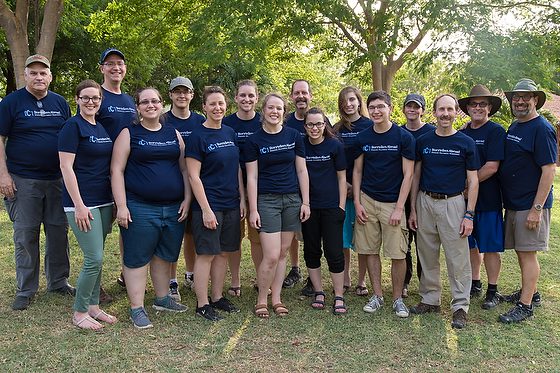Nikon D5, Sigma 24-105mm f/4 DG OS HSM Art Lens, ISO 640, ƒ/9, 1/100
The group photo is our Storytellers Abroad Nicaragua team from this past week. Nicaragua was the third workshop. We have been to Lisbon, Portugal, and Bucharest, Romania.
Bruce Edgar led us one morning for our devotional. Having devotionals led by the local team not only helps us get to know the missionaries of the Nicaraguan team but also helps us focus each day and ask God for guidance. With so much packed into our day with new things to learn and practice, we need a lot of help and rely on God to direct us each day.
Each day we had a different missionary lead us.
I wanted to give you some idea of what students are doing in these workshops and the Honduras Multimedia workshop I have going on this fall and still have openings.
We take some time during the first few days where we spend time in the classroom to help you with that day’s assignment. Here is a photo from our classroom in Managua, Nicaragua.
We first review all the settings for your camera, microphones, and Adobe Premier. Then, we practice recording each other. We spend the Sunday shooting around in some churches where many of our subjects attend, and then we interview like here. On that Monday, leaders try to get out with everyone during the week to help observe you working and give tips.
While some of the students were jumping right into the shooting up and personal with the subjects, we would help those who were shyer and reserved to learn how to take control of the story and get the content they needed to tell the story more effectively.
We start in the classroom and quickly get you out with your subject, shooting for 3 to 5 hours for three days. At the end of your time with the issue, you come back, ingest all your cards, and make notes. After this, you sit with one of the instructors to review your work.
We ask you to identify each of the storyline elements in your story. Your outline will look something like this:
- Subject/Character – A little information about the person you are covering
- Their family
- Their work
- Their volunteer work
- Conflict/Problem – What is the problem that they cannot solve on their own
- Guide/Resource – who is helping them, and what resources are available or lacking?
- Assignment – What does the guide/mentor recommend to help solve the problem for the subject?
- Actions – What actions has the subject taken
- Outcome – Is it a Tragedy or Comedy?
- CALL TO ACTION – We add one more step in the story process: asking the audience a straightforward question and directions on how to get involved. Again, we are not teaching you to entertain with a story but rather to engage the audience until they take action and get involved somehow.
Many of our students have been shooting for years and taking videos or photos to help missions or NGOs tell their stories. So we spend a lot of time helping them break bad habits and giving them the tools to help them do a better job as storytellers.
Stages of Learning
There are stages of learning. Here are the six primary steps, listed from the most rudimentary to the highest levels of comprehension:
- Knowledge (memorizing, recalling)
- Comprehension (expressing ideas in new forms)
- Application (transfer of learning to a unique situation)
- Analysis (breaking a communication down into its parts)
- Synthesis (creating something new by putting pieces together)
- Evaluation (judging value based on standards)

Stages of Learning (from LeRoy Ford’s book “Design for Teaching and Training)
We understand how one learns, so the course is designed to move you to the final stage, where you are functioning at the highest level of evaluation.
We are training you to identify a story and how to produce it so that it connects with the audience and elicits a response, which we call the CALL TO ACTION.
Here I am giving some examples to the class. We then explain how we use visuals to communicate and direct the audience to understand. You will see an example of each thing you learn, then you will also know why we do it a certain way, and then you get to practice those skills yourself. The good thing is each day, we give you feedback on how well you performed. If you fall short, we will send you back to fix it.
In the past few trips, we had some storytellers capture the workshop’s storyRob Llewellyn, who also works with ESPN, jumped in to help one of the students while we were busy with the other students.
Before we leave the country, we do a screening for the subject, the missionaries, and friends. The screening helps us realize there is an absolute deadline to complete this project.
Here is a photo of Jeff Raymond, Team Leader; James Dockery, teacher; and Stanley Leary, a teacher in downtown Managua, Nicaragua. Please consider joining Stanley Leary and Gary S. Chapman in Honduras for a similar workshop from October 29 – November 5, 2016. Honduras Workshop information. 
We haven’t chosen a location or dates for the 2017 Storytellers Abroad workshops, but be sure to bookmark this in your browser and check back often to see about our future seminars.
We made a video while in Lisbon, Portugal, to explain the workshop.












